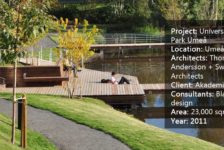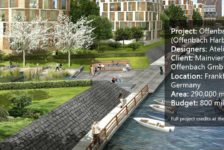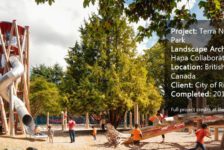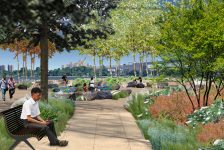We explore the idea that ultimately all public spaces, should be designed with children in mind. Unless a playground is being designed or codes are being reviewed, most landscape architects don’t usually stop to think about how their spaces will be perceived and used by children. But maybe we should? After all, children are future adults and what they believe and do while they are growing up are inevitably the things that will shape the future for not only them but for landscape architecture and us as well. I became pregnant in my second semester of grad school while studying landscape architecture and after having my child and returning to school I suddenly found myself in opposition with many of my classmates and professors over my design choices. All of a sudden every space I saw suddenly was filled with children and all I could think of was how could it be made better for them? No matter how much criticism I received from my professors I was constantly trying to create spaces that were child-friendly and attractive to young families, like myself.
Designing For Children With Child-Friendly Landscape Architecture
One such place that does just this is the Circle in Normal, Illinois. Granted, this space is adjacent to the Children’s Discovery Museum, but it is not a playground, not in the traditional sense anyway. Instead designers included large grassy areas for free play and an educational storm water public fountain. Adults also use both of these but the point here is that children can safely use them right alongside the adults.
While spaces like the Circle still inspire me, I will admit that five years later some of this intense focus on designing just for children has worn off, but I still find myself searching my sites for child hazards and asking my clients if children will ever be using the space.An Interjection From the United Nations
But maybe this isn’t as bad as a certain professor made it out to be in one of my more painful reviews? Maybe there is validity in designing spaces, especially public spaces with children in mind. In fact, it would seem that the United Nations (UN) would agree with me. In 1989, the UN General Assembly adopted the Convention on the Rights of the Child (CRC) to address the lack of representation by children and most importantly it gives children the right to have their voices heard in all matters affecting them. Since its implementation many cities have joined the child bandwagon and have begun to support the child-friendly cities (CFCs) movement.

A city design to be child-friendly at Citygarden. Photo credit: Cameron Rodman

A landscape acting as an example in our article about designing crime our of landscape architecture. Plaza de la Luna by Brut Deluxe and Ben Busche Architects.
Attracting Families is Vital to The Survival of a City
In cities like Detroit, Michigan attracting families back to the downtown area is vital for the survival of the city and here, Campus Martius Park is doing just that. Here, programs such as ice skating and outdoor movies are geared towards families, but the park also has elements that are attractive to people of all ages like bocce ball courts and wireless internet.

“Picture of the skating rink at Campus Martius Park in Downtown Detroit during Super Bowl XL in February 2006” by MJCdetroit. Licensed under GNU Free Documentation License via Wikimedia Commons
If Women and Their Children Feel Safe, Everyone Feels Safe
Since it is located in the center of the central business district it certainly wasn’t designed just for kids but designers were definitely aware of the fact that if women will bring their children alone then the park will be viewed as safe and will be successful.
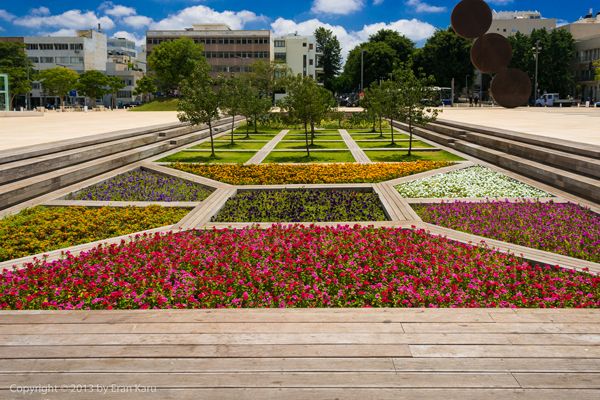
While not designed specifically for children, it is a great place for them. Sunken garden at Habima Square. Photography Credits Go To Eran Karu
How do we do this?
We design outdoor spaces and cities that encourage children to explore and spaces where parents feel confident letting their child play unaccompanied. Both of these things can help a child to develop confidence, build knowledge and maybe even create a sense of pride in their surroundings. And who wouldn’t want to live in a city where a child could safely ride their bike to school? This image portrays a city that is perceived as both safe and clean, which further promotes positive childhood experiences. But how do we do this? There are certain steps that we can take to help cities transform themselves into these child-friendly utopias. We can help municipalities with storm water management, we can design streets that are pedestrian friendly, we can encourage the use of bikes and trails, and we can green up their urban environments.
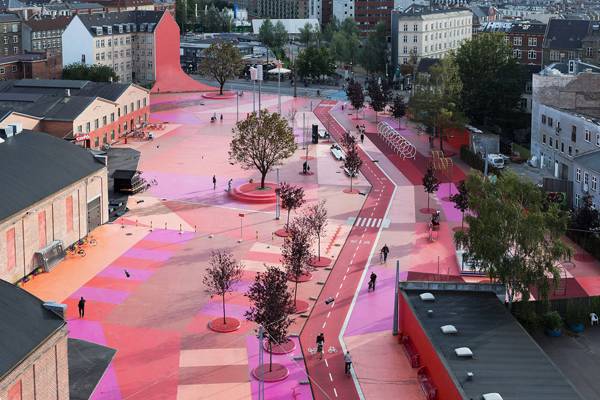
Pedestrian friendly street. “Creative Commons BIG – Bjarke Ingels Group – SUK – Superkilen Park, Copenhagen, Denmark”. Source Forgemind ArchiMedia, licensed under CC 2.0
WATCH: Downtown Bellingham Wa Things To Do
All of these elements add up to create an area that is very attractive to families while also benefitting the local economy, decreasing crime, and making an area more sustainable. Without these sustainable initiatives, children would not be inadvertently exposed to all of the great things that landscape architects do, not only for them but also for their world. It is this idea that hopefully will promote these children to continue the quest of sustainability and maybe, just maybe their childhood experiences will encourage them to go out and create an even better world for their children. And, landscape architecture will inevitably be at the center of the movement. Now, go out and about in your own town or city and take a walk. Are there spaces, other than playgrounds, that you would deem as “child-friendly” and that were designed with the future in mind? Finally, was a landscape architect involved in creating it? Recommended Reading
- Landscape Architecture: An Introduction by Robert Holden
- Landscape Architecture, Fifth Edition: A Manual of Environmental Planning and Design by Barry Starke
Article by Erin Tharp
Return to Homepage Featured image: “BIG – Bjarke Ingels Group – SUK – Superkilen Park – Photo 0003.jpg” by 準建築人手札網站 Forgemind ArchiMedia. Licensed under CC BY-SA 2.0 via Commons. via Flickr
Published in Blog






